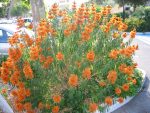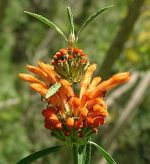 A semi-deciduous shrub, lion’s tail is native to damp grasslands of South Africa and southern Africa, and is a member of the mint family, Lamiaceae, that also includes basil, adjuga, and beebalm. The shrub grows 3-6′ tall and has square stems bearing whorls of medium-dark green leaves that are lance-shaped, 2-4″ long, and aromatic when crushed. From summer into winter tiered whorls of tubular orange flowers rise above the foliage attracting birds and butterflies. Each flowers is 2″ long, fuzzy, and two-lipped. Traditionally the plant was cultivated for its multiple medicinal properties but is now used as an ornamental accent or screen in the garden. It also does well in containers. The genus name, Leonotis, comes from the Greek leōn meaning lion and ous meaning ear. The specific epithet, leonurus, comes from the Greek leon meaning lion and oura meaning tail , and refers to the inflorescence. Photo Credit Wikimedia Commons
A semi-deciduous shrub, lion’s tail is native to damp grasslands of South Africa and southern Africa, and is a member of the mint family, Lamiaceae, that also includes basil, adjuga, and beebalm. The shrub grows 3-6′ tall and has square stems bearing whorls of medium-dark green leaves that are lance-shaped, 2-4″ long, and aromatic when crushed. From summer into winter tiered whorls of tubular orange flowers rise above the foliage attracting birds and butterflies. Each flowers is 2″ long, fuzzy, and two-lipped. Traditionally the plant was cultivated for its multiple medicinal properties but is now used as an ornamental accent or screen in the garden. It also does well in containers. The genus name, Leonotis, comes from the Greek leōn meaning lion and ous meaning ear. The specific epithet, leonurus, comes from the Greek leon meaning lion and oura meaning tail , and refers to the inflorescence. Photo Credit Wikimedia Commons Type: Semi-deciduous tender shrub
Type: Semi-deciduous tender shrub
Outstanding Characteristic: Flowers
Form: Rounded
Growth Rate: Rapid
Bloom: Tiered whorled of tubular orange flowers from summer into winter
Size: 3-6′ H
Light: Full sun to light shade
Soil: Average, medium moist, well-drained, neutral to alkaline; tolerates some drought.
Hardiness: Zones 8-11
Care: Prune yearly after flowering to maintain shape.
Pests and Diseases: None of significance as outdoor plant but susceptible to damage by white flies, gray molds, and spider mites when grown indoors.
Propagation: Seed, greenwood cutting in spring or summer
Outstanding Selections: None available
Photo Credit: Wikipedia